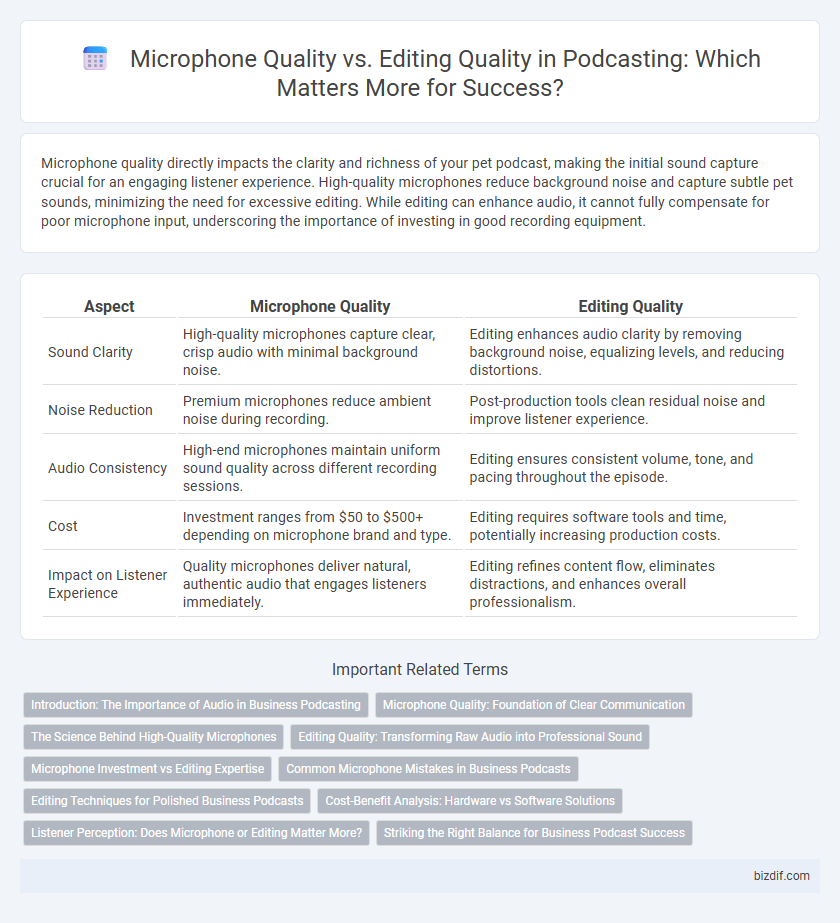Microphone quality directly impacts the clarity and richness of your pet podcast, making the initial sound capture crucial for an engaging listener experience. High-quality microphones reduce background noise and capture subtle pet sounds, minimizing the need for excessive editing. While editing can enhance audio, it cannot fully compensate for poor microphone input, underscoring the importance of investing in good recording equipment.
Table of Comparison
| Aspect | Microphone Quality | Editing Quality |
|---|---|---|
| Sound Clarity | High-quality microphones capture clear, crisp audio with minimal background noise. | Editing enhances audio clarity by removing background noise, equalizing levels, and reducing distortions. |
| Noise Reduction | Premium microphones reduce ambient noise during recording. | Post-production tools clean residual noise and improve listener experience. |
| Audio Consistency | High-end microphones maintain uniform sound quality across different recording sessions. | Editing ensures consistent volume, tone, and pacing throughout the episode. |
| Cost | Investment ranges from $50 to $500+ depending on microphone brand and type. | Editing requires software tools and time, potentially increasing production costs. |
| Impact on Listener Experience | Quality microphones deliver natural, authentic audio that engages listeners immediately. | Editing refines content flow, eliminates distractions, and enhances overall professionalism. |
Introduction: The Importance of Audio in Business Podcasting
High-quality microphones capture clear, professional sound that reduces the need for extensive editing, enhancing listener engagement in business podcasting. Superior audio input minimizes background noise and distortion, ensuring that key messages are conveyed effectively and maintain audience trust. Investing in quality microphones from brands like Shure, Rode, or Audio-Technica directly impacts the overall production value and success of a business podcast.
Microphone Quality: Foundation of Clear Communication
Microphone quality directly impacts the clarity and professionalism of a podcast, capturing authentic sound with minimal distortion or background noise. High-fidelity microphones ensure precise voice reproduction, reducing the need for extensive editing and preserving the speaker's natural tone. Investing in superior microphone hardware establishes a strong foundation, allowing content creators to deliver clear, engaging audio experiences that resonate with listeners.
The Science Behind High-Quality Microphones
High-quality microphones capture a broader frequency range and offer superior sensitivity, significantly reducing background noise before editing. The science behind these microphones involves advanced diaphragm materials and precise electronic circuitry that preserve audio clarity and detail. As a result, superior microphone quality minimizes extensive post-production editing, ensuring a more natural and professional podcast sound.
Editing Quality: Transforming Raw Audio into Professional Sound
Editing quality in podcasting dramatically enhances raw audio by removing background noise, balancing sound levels, and refining tone, resulting in a polished listening experience. High-quality editing compensates for less-than-ideal microphone input, ensuring clarity and consistent audio output crucial for audience engagement. Advanced editing software and skilled technicians transform imperfect recordings into professional-grade sound, elevating overall podcast production value.
Microphone Investment vs Editing Expertise
Investing in a high-quality microphone significantly enhances audio clarity and reduces background noise, creating a professional foundation for any podcast. Superior microphone technology captures richer tones and finer details that editing alone cannot fully replicate or improve. While editing expertise can refine sound and remove imperfections, it cannot compensate for poor microphone quality, making initial equipment investment critical for standout podcast production.
Common Microphone Mistakes in Business Podcasts
Poor microphone quality often results in background noise, distortion, and inconsistent audio levels that editing cannot fully rectify in business podcasts. Common microphone mistakes include using low-quality or unidirectional mics that fail to capture clear voice tones, improper mic placement causing popping sounds or muffled speech, and neglecting pop filters or windshields. Investing in professional-grade microphones and employing proper recording techniques significantly reduce post-production editing time and enhance overall podcast sound clarity.
Editing Techniques for Polished Business Podcasts
Editing techniques such as noise reduction, equalization, and dynamic range compression significantly enhance podcast audio, often compensating for moderate microphone quality. Advanced editing software enables fine-tuning of vocal clarity, removal of background noise, and balancing audio levels to produce a professional and polished business podcast. Investing time in meticulous editing ensures consistent sound quality, engaging listener experience, and a credible podcast brand, even when using mid-range microphones.
Cost-Benefit Analysis: Hardware vs Software Solutions
High-quality microphones capture clearer audio with less background noise, reducing the need for extensive post-production editing and thereby saving time and effort. Editing software can compensate for some audio imperfections but often requires advanced skills and more time investment, which may increase overall production costs. Evaluating the cost-benefit analysis reveals that investing in a better microphone upfront generally yields more consistent sound quality and efficiency compared to relying heavily on software for audio correction.
Listener Perception: Does Microphone or Editing Matter More?
Listener perception in podcasting is heavily influenced by microphone quality and editing quality, each playing distinct roles in the overall experience. High-quality microphones capture clear, natural sound that establishes credibility and engagement, while skilled editing removes distractions such as background noise and awkward pauses, enhancing flow and professionalism. Research shows that audiences prioritize clarity and content cohesion, indicating that balanced investment in both microphone equipment and editing software yields the best listener satisfaction.
Striking the Right Balance for Business Podcast Success
Microphone quality directly influences the clarity and professionalism of a business podcast, capturing crisp audio that engages listeners effectively. Editing quality enhances the final product by removing noise, balancing sound levels, and adding seamless transitions to maintain listener interest. Striking the right balance between high-quality microphones like the Shure SM7B and skilled editing techniques ensures an impactful, polished podcast that builds brand credibility and audience loyalty.
Microphone quality vs editing quality Infographic

 bizdif.com
bizdif.com